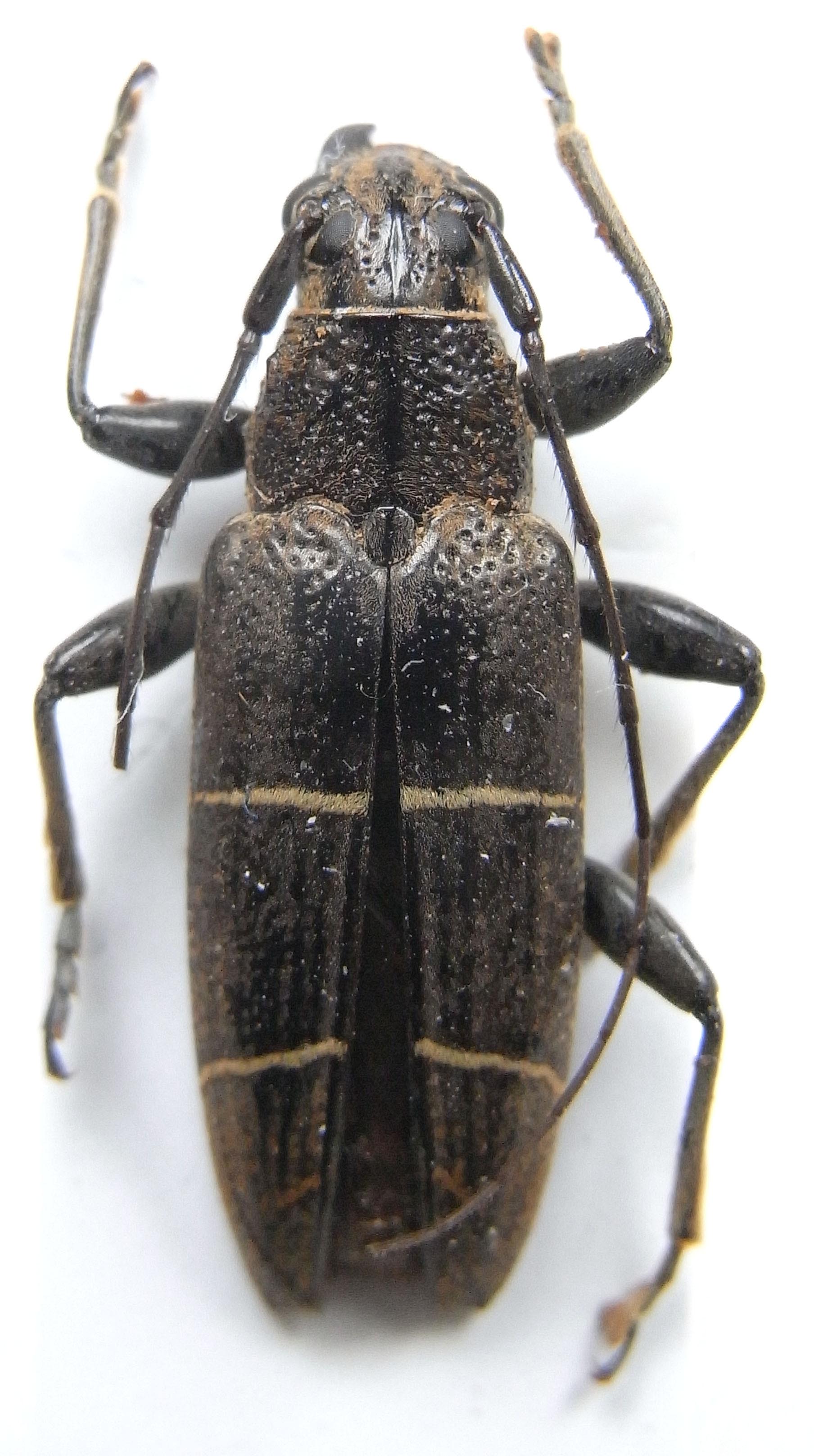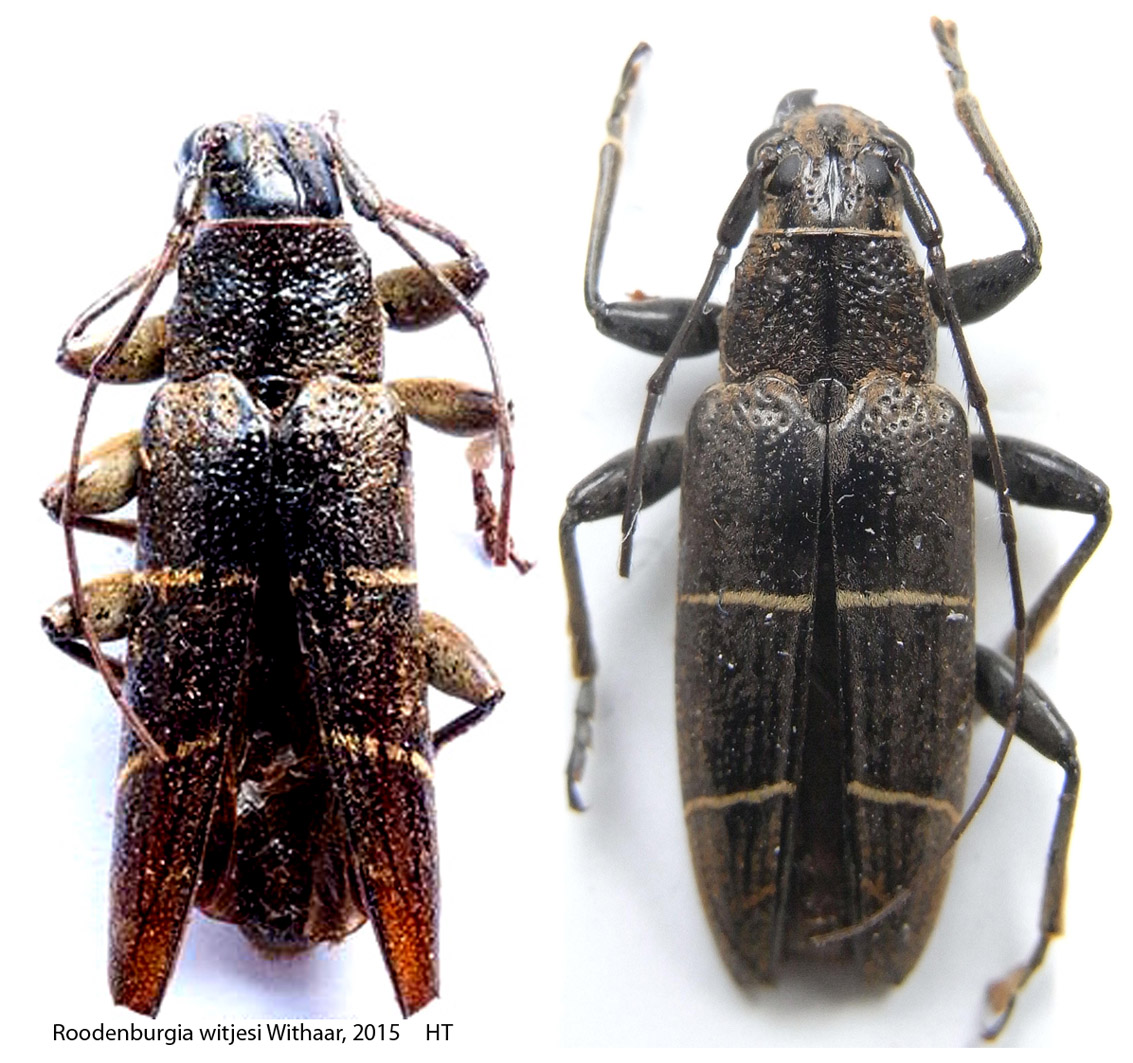| T O P I C R E V I E W |
| Xavier |
Posted - 03/01/2012 : 20:06:49

14 mm.
Côte nord d'Irian Jaya.
Un Sphingnotus pour ses deux bandes blanches ?
Mais je ne connais pas du tout ce groupe ... |
| 15 L A T E S T R E P L I E S (Newest First) |
| Xaurus |
Posted - 27/10/2016 : 00:49:13
This was my attention before his publication, in his new paper there are also new sps in very bad condition, really difficult to recognize after description, especially in the genus Tmesisternus spms with a good tomentation are necessary for ID and for descriptions particularly.
According my opinion the new Ro(o)denburgia [valid is Rodenburgia] sps belong to T. trivittatus and T. oblongus, both are common ones in New Guinea. |
| Vitali |
Posted - 26/10/2016 : 10:08:03
quote:
Originally posted by Francesco
They are probably two immature specimens deformed by alcohol and successive drying. I observed the same phenomenon in some Prionus coriarius of our collection in Luxembourg.
I am working with Uganda material collected by Malaise traps in alcohol.
If a special care about fixing elytra is not taken at drying the specimens, they all become new for science.
Incredible motivation for introducing new genera! |
| Xavier |
Posted - 26/10/2016 : 09:41:41
I have also seen both pictures on internet before reading the paper but I could not imagine that deformed wings were the definition of a "new genus". You did! 
By looking to my collection, I have many new genera  |
| Francesco |
Posted - 26/10/2016 : 09:14:02
quote:
Originally posted by Xavier
Francesco, did you read this before ?
No, I did not. There are two pictures on the Web here.
They are probably two immature specimens deformed by alcohol and successive drying. I observed the same phenomenon in some Prionus coriarius of our collection in Luxembourg. |
| Xavier |
Posted - 26/10/2016 : 07:41:46
I just received the paper of Withaar (2015) (Merci Jean-Philippe !  ), and I read this ), and I read this  : :
<< The genus Roodenburgia gen. nov. differs from its sister genus Tmesisternus Latreille, 1829 in having deverging and wrinkled elytra.>>
Francesco, did you read this before ? |
| Xavier |
Posted - 26/10/2016 : 07:29:15
...and in Titan database, Tmesisternus trivitatus Guérin-Méneville, 1831 = Tmesisternus bizonulatus Guérin-Méneville, 1831 |
| Xavier |
Posted - 26/10/2016 : 06:37:29
Yes, he published it in 2015, ...maybe you could ask him his paper to understand the definition of the new genus?
What about my specimen? Tmesisternus (trivittatus?) or Roodenburgia? |
| Xaurus |
Posted - 26/10/2016 : 00:45:51
Yes, I know Gerrit well, we are been together in Westpapua already.
As I remember, he sent his manuscript to me at beginning of this year or last year, and I told him please don't publish this new genus with such disfigured and maybe immature spms. Obviously it's already publish, I don't know ? |
| Xavier |
Posted - 25/10/2016 : 23:44:26
Do you know the author?
He describes another species in the same new genus ... I asked him his paper, but still no answer. |
| Xaurus |
Posted - 25/10/2016 : 23:40:37
Roodenburgia   |
| Francesco |
Posted - 25/10/2016 : 21:52:44
Cette Roodenburgia a tout l'aire d'être basée sur des exemplaires tératologiques... |
| Xavier |
Posted - 25/10/2016 : 18:30:29
quote:
Originally posted by Capitaine
Effectivement, et il y a aussi la couleur des fémurs black sur ton ex. et "panaché" sur l'holotype ! à suivre....
L'holotype a été capturé en ...1928 ! (cf base Titan), ce qui explique sans doute l'état du spécimen.
Une autre différence me semble la position de la bande claire postmédiane, un peu plus éloignée de l'apex chez Roodenburgia witjesi. |
| Xavier |
Posted - 25/10/2016 : 18:23:56
J'ai demandé à l'auteur la copie de son article. |
| Capitaine |
Posted - 25/10/2016 : 17:11:39
Effectivement, et il y a aussi la couleur des fémurs black sur ton ex. et "panaché" sur l'holotype ! à suivre.... |
| Xavier |
Posted - 25/10/2016 : 16:36:41

315.43 KB
Pour comparer.
La seule différence semble la forme des élytres, mais c'est sans doute du à leur position. |


